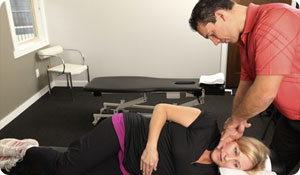
From traction tables to decompression belts, spinal decompression is advertised as a sure-fire technique to relieve chronic back pain. But does spinal decompression work?
Spinal decompression involves stretching tight spinal muscles and moving spinal discs in order to relieve back pain. According to the American Chiropractic Association (ACA), almost two-thirds of chiropractors report using spinal manipulation techniques for spinal decompression at least occasionally.
According to the ACA, spinal discs are filled with a gelatinous fluid that sometimes leaks out and causes pain. Decompression therapy is a form of traction that uses weights to pull the discs slightly apart. This creates negative pressure inside the discs (like a vacuum) that sucks the fluid back in.
There are lots of decompression devices on the market ranging from decompression belts patients can buy online to inversion boots that have them hang upside down. While many advertisers claim their products provide extremely high rates of relief, there are no studies that support their claims. Some patients say these products relieved their back pain long term while others say they only worked while they were actively being used. For example, the decompression belt may have helped while they wore it, but once they took it off, the pain returned. Still more patients, however, said the belts and boots were uncomfortable, impractical and didn't do a thing for them.
In chiropractic offices, there are decompression/traction tables that use rollers, weights, and pulleys to move the discs apart so the chiropractor can perform a hands-on technique to decompression the disc and move the joint through it's full range of motion.
One specific technique called the Cox Flexion Distraction and Decompression Chiropractic Spinal Adjustment has been researched and found to be effective for controlling pain for many patients including those with slipped, herniated or ruptured discs, spondylolisthesis, stenosis, and other conditions.
The patient lies on a customized traction table while a specially trained chiropractor performs the Cox technique to move the bones and joints.
The problem for many patients who receive this therapy is that many chiropractors that perform decompression therapy have not been properly trained in the Cox technique. They may invest in an expensive traction bed, but don't use the hands-on technique that's been shown to provide the most relief. In fact, many chiropractors simply place the patient on the bed and let the rollers, weights and/or pulleys to do the work for them. That method of decompression has not been shown to be an effective treatment for back pain.
The truth about spinal decompression seems to be more about the hands-on technique than about any specific device (other than the Cox traction table). Custom trained and certified practitioners who have the right type of traction table and use the Cox technique seem to have the best results. Those who don't...not so much.
Ask your chiropractor if he/she is trained and certified in the Cox technique. Think twice before spending money on devices sold online for home use. Do your homework and ask your healthcare provider about research studies that support the decompression techniques she uses.
Sources:
The Cox Technique
http://www.coxtechnic.com/default.aspx
The American Chiropractic Association
Vertebral Axial Decompression
By Rebecca Jones
https://www.acatoday.org/print.cfm?CID=4683





